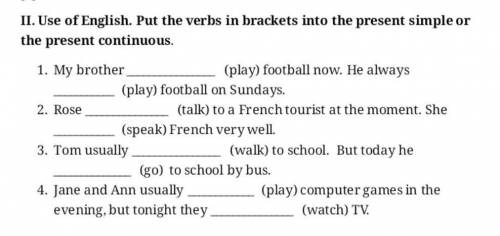1. My brother (play) football now. He always (play) football on Sundays. 2. Rose (talk) to a French tourist at the moment. She (speak) French verywell 3. Tom usually (walk) to school. But today he (go) to school by bus. 4. Jane and Ann usually (play) computer games in the evening, but tonight they (watch) TV

Другие вопросы по теме Английский язык
Популярные вопросы
- Значение -польской войны в россии (1609-1618)...
1 - Главная мысль сказки буратино 10 зарание...
2 - Какая форма слоевища у лишайника накипного?...
1 - 8класс () запишите электронную конфигурацию и электронно-графическую формулу...
3 - Главная мысль сказки возвращение блутного попугая зарание...
1 - 1. у якому з цих речень ми не повинні відокремлювати поширене означення? а. кіт...
1 - Разобраться в вопросе полезен ли загар для детей?...
1 - Примеры хороших семей в книгах (зарубежных писателей). можно цитаты....
2 - На графике функции y=3x+8 найдите точку, абцисса которая противоположная ординате...
2 - Выражения: -9 5/7-y+4 7/12+9 5/7+y-3 11/18...
2
1 player
2 talking
3 speaking
4 walking
5 going
6 player
7 watching
Explanation: The first sentence in the present continuous tense describes an action happening at the moment of speaking. In this case, the action is playing football. The second sentence in the simple present tense describes a regular action that happens every Sunday.
Step-by-step solution:
- To form the present continuous tense, we use the subject followed by the helping verb "is" and the base form of the verb + "ing". Therefore, "My brother" + "is" + "playing."
- To form the simple present tense, we use the subject followed by the base form of the verb. Therefore, "He" + "plays."
2. Rose is talking to a French tourist at the moment. She speaks French very well.
Explanation: The first sentence in the present continuous tense describes an action happening at the moment of speaking. In this case, the action is talking to a French tourist. The second sentence in the simple present tense describes a general ability or fact about Rose.
Step-by-step solution:
- To form the present continuous tense, we use the subject followed by the helping verb "is" and the base form of the verb + "ing". Therefore, "Rose" + "is" + "talking."
- To form the simple present tense, we use the subject followed by the base form of the verb. Therefore, "She" + "speaks."
3. Tom usually walks to school. But today he is going to school by bus.
Explanation: The first sentence in the simple present tense describes a regular action that happens every day. In this case, the action is walking to school. The second sentence in the present continuous tense describes an action happening at the moment of speaking. In this case, the action is going to school by bus.
Step-by-step solution:
- To form the simple present tense, we use the subject followed by the base form of the verb. Therefore, "Tom" + "usually walks."
- To form the present continuous tense, we use the subject followed by the helping verb "is" and the base form of the verb + "ing". Therefore, "He" + "is" + "going."
4. Jane and Ann usually play computer games in the evening, but tonight they are watching TV.
Explanation: The first sentence in the simple present tense describes a regular action that happens every evening. In this case, the action is playing computer games. The second sentence in the present continuous tense describes an action happening at the moment of speaking. In this case, the action is watching TV.
Step-by-step solution:
- To form the simple present tense, we use the subject followed by the base form of the verb. Therefore, "Jane and Ann" + "usually play."
- To form the present continuous tense, we use the subject followed by the helping verb "are" and the base form of the verb + "ing". Therefore, "They" + "are" + "watching."